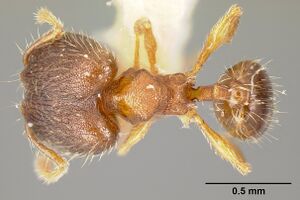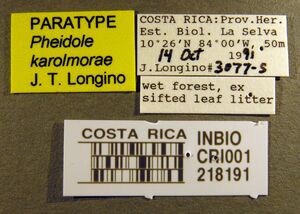Pheidole karolmorae
| Pheidole karolmorae | |
|---|---|

| |
| Scientific classification | |
| Kingdom: | Animalia |
| Phylum: | Arthropoda |
| Class: | Insecta |
| Order: | Hymenoptera |
| Family: | Formicidae |
| Subfamily: | Myrmicinae |
| Tribe: | Attini |
| Genus: | Pheidole |
| Species: | P. karolmorae |
| Binomial name | |
| Pheidole karolmorae Longino, 2009 | |
Pheidole karolmorae occurs throughout Costa Rica in lowland wet forest habitats, from sea level to 800m. It is known exclusively from Winkler and Berlese samples of forest floor leaf litter; the nest is unknown. Major and minor workers are found in litter samples, and one dealate queen has been tentatively associated with workers. The species is relatively common at La Selva Biological Station and nearby Braulio Carrillo National Park, occurring in many litter samples. However, it has never been collected at a bait, in spite of abundant baiting samples from La Selva. This suggests that it is strongly restricted to foraging in and under the litter. (Longino 2009)
Identification
Longino (2009) - With the morphometric profile of a large number of small Pheidole: Pheidole ademonia, Pheidole arhuaca, Pheidole cardiella, Pheidole constipata, Pheidole darlingtoni, Pheidole flavens, Pheidole funki, Pheidole harrisonfordi, Pheidole karolsetosa, Pheidole micridris, Pheidole meinertopsis, Pheidole oaxacana, Pheidole sabella, Pheidole sculptior. Minor worker: head relatively broad, CI about 97, versus head relatively narrow, CI 88–93 (flavens); clypeus punctate versus smooth and shining (harrisonfordi); promesonotum somewhat box-like and dropping abruptly to metanotal groove versus more evenly arched (ademonia) or box-like but not dropping as abruptly to metanotal groove (flavens, harrisonfordi, oaxacana); promesonotal humeri not at all produced versus relatively more developed (oaxacana); promesonotal groove completely absent versus weakly impressed (meinertopsis); side of pronotum and katepisternum uniformly and strongly foveolate versus faintly foveolate to smooth and shining (ademonia); pilosity of mesosomal dorsum and first gastral tergite moderately abundant versus relatively sparser and more regular (ademonia, constipata); petiolar node relatively robust, proportionately large relative to anterior petiolar peduncle, apex fully foveolate, versus petiolar node smaller, proportionately smaller relative to anterior peduncle, apex smooth and shiny (harrisonfordi, oaxacana); dorsal (outer) margin of hind tibia with short decumbent pilosity only, no long erect hairs, versus with three or more long erect setae on dorsal surface of hind tibia, longer than maximum width of tibia and differentiated from underlying shorter subdecumbent pubescence (karolsetosa, oaxacana); color uniformly orange brown versus bicolored, mesosoma light yellow white, head and gaster darker (darlingtoni, endemic to Haiti). Major worker: head in lateral view deep, with strongly convex dorsal surface, versus head relatively flatter in lateral view, with less convex dorsal surface (constipata, flavens, harrisonfordi); head with moderately convex sides and posterior margin shallowly emarginate versus with more convex sides and more strongly cordate posterior margin (cardiella); inner hypostomal teeth present versus absent (micridris); face rugose foveolate throughout, rugae reticulate on posterior half, versus posterior face more coarsely rugose with shiny interspaces (ademonia) or vertex lobes smooth and shiny (arhuaca, sabella) or vertex lobes more uniformly foveolate with reduced rugulation (meinertopsis); antennal scrobe absent versus weakly developed (ademonia, cardiella, flavens, sculptior) or strongly developed (funki); pilosity on dorsal surface of mandible relatively abundant, long, suberect, versus sparse, short, fully appressed (ademonia); foveolate sculpture of face wrapping around onto ventral surface of head versus posteroventral portion of head capsule smooth and shiny (ademonia); face uniformly red brown versus orange with medial dark brown spot (oaxacana); promesonotum somewhat box-like and dropping abruptly to metanotal groove versus more evenly arched (ademonia) or box-like but not dropping as abruptly to metanotal groove (flavens); promesonotal groove completely absent versus weakly impressed (meinertopsis, sabella); side of pronotum foveolate versus smooth and shiny (ademonia, arhuaca); postpetiole in dorsal view trapezoidal versus strongly transverse and conulate (harrisonfordi); pilosity of mesosomal dorsum and first gastral tergite moderately abundant versus relatively sparser and more regular (constipata); dorsal (outer) margin of hind tibia with short decumbent pilosity only, no long erect hairs, versus with three or more long erect setae on dorsal surface of hind tibia, longer than maximum width of tibia and differentiated from underlying shorter subdecumbent pubescence (karolsetosa, oaxacana).
Distribution
Latitudinal Distribution Pattern
Latitudinal Range: 15.6864989° to 8.7°.
| North Temperate |
North Subtropical |
Tropical | South Subtropical |
South Temperate |
- Source: AntMaps
Distribution based on Regional Taxon Lists
Neotropical Region: Costa Rica (type locality), Honduras, Nicaragua.
Distribution based on AntMaps
Distribution based on AntWeb specimens
Check data from AntWeb
Countries Occupied
| Number of countries occupied by this species based on AntWiki Regional Taxon Lists. In general, fewer countries occupied indicates a narrower range, while more countries indicates a more widespread species. |

|
Estimated Abundance
| Relative abundance based on number of AntMaps records per species (this species within the purple bar). Fewer records (to the left) indicates a less abundant/encountered species while more records (to the right) indicates more abundant/encountered species. |

|
Biology
Castes
Worker
Minor
Images from AntWeb
   
| |
| Paratype Pheidole karolmorae. Worker. Specimen code inbiocri002279841. Photographer Stephanie Ware, uploaded by Field Museum. | Owned by FMNH. |

| |
| Paratype Pheidole karolmorae. Worker. Specimen code casent0608995. Photographer J. Russ, uploaded by California Academy of Sciences. | Owned by JTLC. |
Major
Images from AntWeb
   
| |
| Holotype Pheidole karolmorae. Worker (major/soldier). Specimen code inbiocri002279843. Photographer J. Russ, uploaded by California Academy of Sciences. | Owned by INBC. |
 
| |
| Paratype Pheidole karolmorae. Worker (major/soldier). Specimen code inbiocri001218186. Photographer J. Longino, uploaded by University of Utah. | Owned by JTLC. |
Queen
Images from AntWeb
   
| |
| Paratype Pheidole karolmorae. Queen (alate/dealate). Specimen code inbiocri001218191. Photographer J. Russ, uploaded by California Academy of Sciences. | Owned by JTLC. |
   
| |
| Queen (alate/dealate). Specimen code inbiocri002279840. Photographer J. Russ, uploaded by California Academy of Sciences. | Owned by JTLC. |
Nomenclature
The following information is derived from Barry Bolton's Online Catalogue of the Ants of the World.
- karolmorae. Pheidole karolmorae Longino, 2009: 41, fig. 10 (s.w.) COSTA RICA.
Unless otherwise noted the text for the remainder of this section is reported from the publication that includes the original description.
Description
Worker
Minor Measurements (paratype): HL 0.38, HW 0.38, HLA 0.10, SL 0.31, EL 0.09, ML 0.40, PSL 0.04, PMG 0.00, SPL 0.02, PTW 0.08, PPW 0.11, CI 99, SI 83, PSLI 10, PMGI 0, SPLI 5, PPI 139.
Measurements (n=11): HL 0.38-0.42, HW 0.36-0.40, SL 0.31-0.38, CI 90-99, SI 83-103.
Clypeus foveolate; face uniformly foveolate; margin of vertex rounded with median impression; occipital carina narrow, not visible in full face view; scape with abundant erect setae longer than maximum width of scape; promesonotal groove absent; propodeal spines present; entire mesosoma foveolate; abundant setae on promesonotal dorsum; dorsal (outer) margin of hind tibia with short decumbent pilosity, no long erect hairs; first gastral tergum smooth and shining; gastral dorsum with moderately abundant, somewhat stiff setae; color orange.
Major Measurements (holotype): HL 0.76, HW 0.74, HLA 0.15, SL 0.37, EL 0.10, ML 0.53, PSL 0.07, PMG 0.00, SPL 0.04, PTW 0.12, PPW 0.17, IHT 0.14, OHT 0.26, CI 97, SI 51, PSLI 10, PMGI 0, SPLI 5, PPI 143, HTI 52.
Measurements (n=9): HL 0.74-0.83, HW 0.70-0.80, SL 0.37-0.44, CI 93-99, SI 51-55.
Head in lateral view deep, with strongly convex dorsal surface; mandible smooth and shiny; clypeus smooth and flat with shallow anterior notch; face rugose foveolate throughout; rugae reticulate on posterior half, increasingly longitudinal and subparallel on anterior half; head with abundant suberect setae projecting from sides of head in face view; scape smooth and shining, terete at base, with abundant erect setae longer than maximum width of scape; hypostomal margin gently curved; median tooth small; inner hypostomal teeth pointed, stout, about one half distance from midline to outer hypostomal teeth; promesonotal groove absent; propodeal spines present; mesosoma largely foveolate; dorsal (outer) margin of hind tibia with short decumbent pilosity, no long erect hairs; pilosity abundant on mesosomal dorsum; first gastral tergite smooth and shining or with variable extent of faint, patchy foveolae near postpetiolar insertion, with abundant flexuous erect setae; color orange brown.
Type Material
Holotype major worker. Costa Rica, Heredia: La Selva, 8km SW Pto. Viejo, 10.40000°N 84.05000°W, ±2000m, 150m, 17 Jul 1986 (J. Longino#1391-s) Instituto Nacional de Biodiversidad, unique specimen identifier INBIOCRI002279843.
Paratypes: major and minor workers. Same data as holotype; same locality as holotype but 14 Oct 1991 (J. Longino#3077-s, #3078-s), 2 Jul 1992 (J. Longino#3203-s) Field Museum of Natural History, Instituto Nacional de Biodiversidad,John T. Longino Collection, Museum of Comparative Zoology, University of California, Davis, National Museum of Natural History.
Etymology
This species is named for Karol Mora. Karol worked for several years with Conservation International's TEAM project at La Selva Biological Station, during the time when the project was sampling litter ants as a means of assessing and monitoring biotic response to climate change. Karol was solely responsible for processing the litter samples for ants. Her keen observational skills, ability to recognize hundreds of ant species, and unflagging dedication to the project resulted in a dataset and ant collection that is a major contribution to our knowledge of Neotropical ant communities.
References
- Longino, J.T. 2009. Additions to the taxonomy of New World Pheidole. Zootaxa 2181: 1-90. PDF
References based on Global Ant Biodiversity Informatics
- Longino J. T. 2009. Additions to the taxonomy of New World Pheidole (Hymenoptera: Formicidae). Zootaxa 2181: 1-90.
- Longino J. T. 2013. Ants of Nicargua. Consulted on 18 Jan 2013. https://sites.google.com/site/longinollama/reports/ants-of-nicaragua
- Longino J. T. L., and M. G. Branstetter. 2018. The truncated bell: an enigmatic but pervasive elevational diversity pattern in Middle American ants. Ecography 41: 1-12.
- Longino J. T., and R. K. Colwell. 2011. Density compensation, species composition, and richness of ants on a neotropical elevational gradient. Ecosphere 2(3): 16pp.
- Longino J. et al. ADMAC project. Accessed on March 24th 2017 at https://sites.google.com/site/admacsite/

